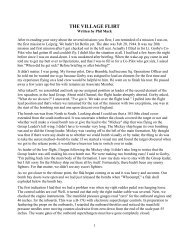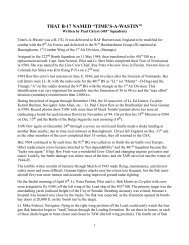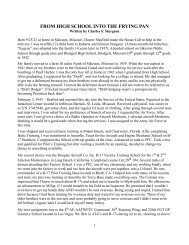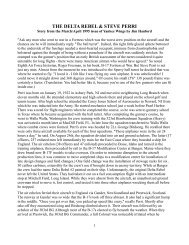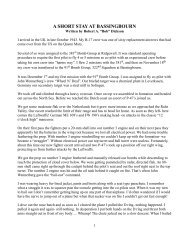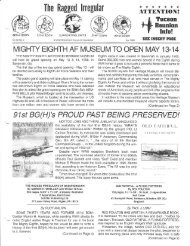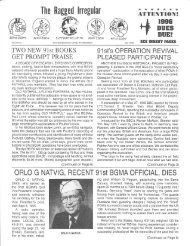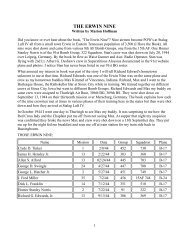Dailies of the 323rd - the 91st Bomb Group!
Dailies of the 323rd - the 91st Bomb Group!
Dailies of the 323rd - the 91st Bomb Group!
Create successful ePaper yourself
Turn your PDF publications into a flip-book with our unique Google optimized e-Paper software.
France, was bombed. This was a tactical operation in cooperation<br />
with <strong>the</strong> invasion troops. It being “D” Day, a special effort was<br />
made to send up a good formation. Twelve ships from this squadron<br />
took part as follows: #7173, Lt. Kerr and crew; #7176, Lt. Stunf<br />
and crew; #7540, Lt. Pickard and crew; #7304, Lt. Pryor and crew;<br />
#1759, Lt. Helfrich and crew; #7075, Lt. Miller and crew; #7040,<br />
Lt. Maxwell and crew; #1542, Lt. Supchak and crew; and #1909, Lt.<br />
Klinger and crew; #2116, Lt. Bruce and crew; #2490, Lt. Sheriff<br />
and crew; #7956, Lt. Col. Berry, and Lt. Reid, in a lead ship<br />
with <strong>the</strong> “A” crew. <strong>Bomb</strong>ing <strong>of</strong> <strong>the</strong> enemy gun emplacements was<br />
unobserved as to <strong>the</strong> actual results. All ships returned safely to<br />
base, and <strong>the</strong>re were no abortives.<br />
Crews not flying went to ground school and participated in<br />
training activities, but due to <strong>the</strong> situation pending at <strong>the</strong><br />
time, this was on a limited scale. The crews were alerted for<br />
ano<strong>the</strong>r mission that day, but it did not materialize.<br />
th<br />
7 June 1944: On <strong>the</strong> 7 , an Airfield at Kerlin/Bastard was<br />
partially destroyed by our bombers. Eight <strong>of</strong> our ships<br />
participated as follows: #7563, Lt. Stunf and crew; #7540, Lt.<br />
Pickard and crew; #7075, Lt. Kerr and crew; #2116, Lt. Helfrich<br />
and crew; #1909, Lt. Klinger and crew; #7173, Lt. Miller and<br />
crew; #7040, Lt. Maxwell and crew; #7340, Lt. Pryor and crew. All<br />
returned safely to base and <strong>the</strong>re were no abortives.<br />
At this particular time, when <strong>the</strong> invasion <strong>of</strong> continental Europe<br />
is underway, all personnel are held ready and available for<br />
immediate duty, regardless <strong>of</strong> <strong>the</strong> number <strong>of</strong> missions <strong>the</strong>y have<br />
flown in <strong>the</strong> past. For this reason, no one is being relieved from<br />
combat duty after completion <strong>of</strong> thirty missions. Several<br />
individuals have that number to <strong>the</strong>ir credit but are still on<br />
duty with <strong>the</strong> squadron. Their training and combat experience<br />
enable <strong>the</strong>m to be <strong>of</strong> much value to <strong>the</strong> service at this time.<br />
8 June 1944: On <strong>the</strong> 8 , a railroad bridge over <strong>the</strong> Loire River<br />
th<br />
was bombed. Results were considered successful. Nine ships<br />
started on this mission as follows: #2490, Lt. Sheriff and crew;<br />
#7504, Lt. Bruce and crew; #1542, Lt. Supchak and crew; #7304,<br />
Lt. Pryor and crew; #7563, Lt. Stunf and crew; #1909, Lt. Klinger<br />
and crew; #7234, Capt. Ranzoni and crew; #7173, Lt. Miller and<br />
crew; #2116, Lt. Grimmer and crew. All ships returned safely to<br />
base. There were 3 abortives. Ship #7504 aborted – No. 2 engine<br />
was detonating and running rough. This was investigated by <strong>the</strong><br />
Squadron Commander who found that <strong>the</strong> engine showed signed <strong>of</strong><br />
detonation above 35” HG. Above 12,000 ft. Also that above 20,000<br />
ft., No 1 engine showed signed <strong>of</strong> detonation above 37” HG.<br />
However, using low power settings on <strong>the</strong>se engines, he<br />
experienced no trouble getting <strong>the</strong> aircraft to altitude and




